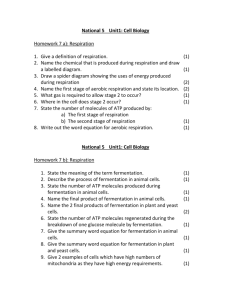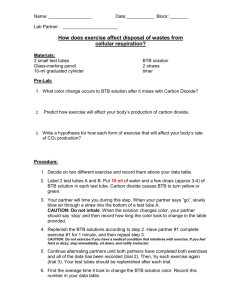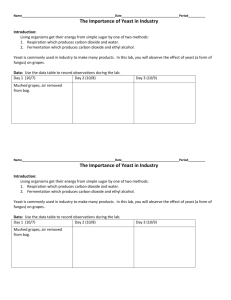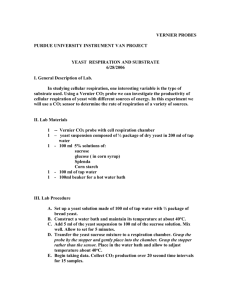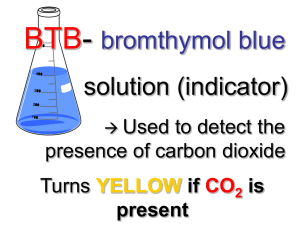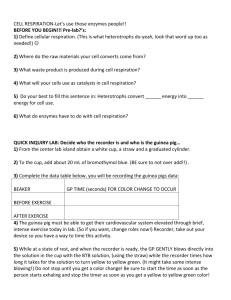Bromthymol Blue pH Color Chart
advertisement
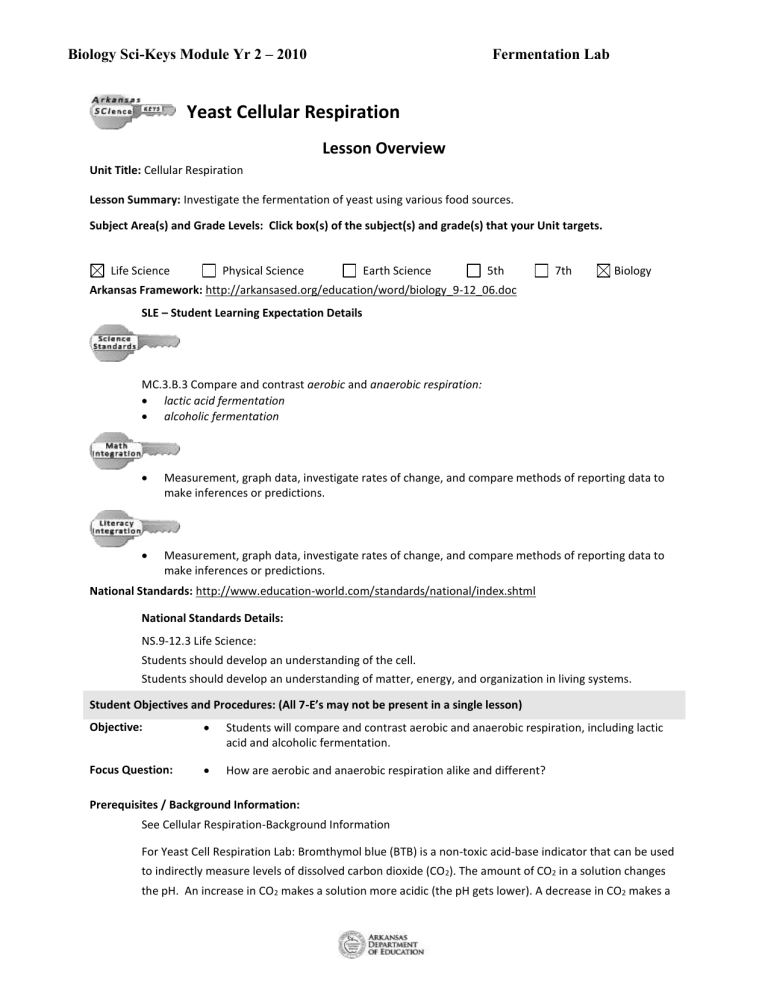
Biology Sci-Keys Module Yr 2 – 2010 Fermentation Lab Yeast Cellular Respiration Lesson Overview Unit Title: Cellular Respiration Lesson Summary: Investigate the fermentation of yeast using various food sources. Subject Area(s) and Grade Levels: Click box(s) of the subject(s) and grade(s) that your Unit targets. Life Science Physical Science Earth Science 5th 7th Biology Arkansas Framework: http://arkansased.org/education/word/biology_9-12_06.doc SLE – Student Learning Expectation Details MC.3.B.3 Compare and contrast aerobic and anaerobic respiration: lactic acid fermentation alcoholic fermentation Measurement, graph data, investigate rates of change, and compare methods of reporting data to make inferences or predictions. Measurement, graph data, investigate rates of change, and compare methods of reporting data to make inferences or predictions. National Standards: http://www.education-world.com/standards/national/index.shtml National Standards Details: NS.9-12.3 Life Science: Students should develop an understanding of the cell. Students should develop an understanding of matter, energy, and organization in living systems. Student Objectives and Procedures: (All 7-E’s may not be present in a single lesson) Objective: Students will compare and contrast aerobic and anaerobic respiration, including lactic acid and alcoholic fermentation. Focus Question: How are aerobic and anaerobic respiration alike and different? Prerequisites / Background Information: See Cellular Respiration-Background Information For Yeast Cell Respiration Lab: Bromthymol blue (BTB) is a non-toxic acid-base indicator that can be used to indirectly measure levels of dissolved carbon dioxide (CO 2). The amount of CO2 in a solution changes the pH. An increase in CO2 makes a solution more acidic (the pH gets lower). A decrease in CO2 makes a Biology Sci-Keys Module Yr 2 – 2010 Fermentation Lab solution more basic (the pH gets higher). The reason for this is that carbon dioxide that is dissolved in water is in equilibrium with carbonic acid (H2CO3). CO2 + H2O ↔ H2CO3 In any solution, while the majority of CO2 stays as CO2, some of it is converted to H2CO3, turning the solution slightly acidic. If CO2 is added to the water, the level of H2CO3 will rise and the solution will become more acidic. If CO2 is removed from the water, the amount of H2CO3 falls and the solution becomes more basic. Thus, acid-base indicators such as BTB can indirectly measure the amount of CO 2 in a solution. Bromthymol Blue pH Color Chart YELLOW W GREEN BLUE Also known as: 3',3''-dibromothymolsulfonephtalein Type: HIn + H2O In- + H3O+ 6.0-7.6 Color of acid form: yellow pK: 7.30 Approximate pH range for color change: Color of base form: blue Source: http://antoine.frostburg.edu/chem/senese/101/acidbase/indicators.shtml, last accessed 25 Feb 2010. Timeline: Preparation: Elicit/Engage: Explore: Explain: Cleanup: 1 hour 15 minutes 35-40 minutes 20 minutes 5-10 minutes Teacher Preparation: Teacher Preparation – For 6 groups of 4 students 1. Stock Yeast Solution: At least 15 minutes prior to the lab, mix 2 packets (or 14 grams) of bread yeast with 120mL of lukewarm water (100°F/38°C). Stir for 2 minutes or until all the yeast is dissolved. Stir again just before use. (Yeast will survive an hour or more in solution.) 2. Stock Sugar Solution: Dissolve 15g of sugar in 120mL of lukewarm water. Stir for 2 minutes or until all the sugar is dissolved. 3. Stock BTB Solution: Just prior to use, add 100ml of 0.04% BTB solution to 900ml of warm (38° C) distilled water. When mixed with distilled water, the BTB solution will be green. The BTB solution must be held at approximately this temperature until use. 4. Distilled Water: 100mL at room temperature. 5. Divide the students into teams with 4 students in each. Be sure each team member understands their role. Assign the following roles: Manager/Timer, Control Biology Sci-Keys Module Yr 2 – 2010 Fermentation Lab Recorder/Observer, Experiment A Recorder/Observer, Experiment B Recorder/Observer. Materials: Materials Per Group: 10 - Medicine cups 1- 250mL Beaker 10 ml Distilled water 15mL of Stock Yeast Solution 10mL of Stock Sugar Solution 160mL of Stock Bromthymol Blue (BTB) Solution 3 - Disposable plastic pipettes 3 - Metal hex nuts 3 - 50mL Graduated cylinders 1- Stopwatch Safety goggles Technology – Hardware: (Click boxes of all equipment needed) Camera Computer(s) Digital Camera Projection System Television Video Camera Internet Connection VCR Other: Technology – Software: (Click boxes of all software needed.) Database/Spreadsheet Internet Web Browser Multimedia Word Processing Other: Internet Resources: adapted from http://www.mysciencebox.org/bubblingyeast) Procedures: Teacher’s Notes: Safety goggles What do pickles, bread, yogurt, wine, beer, and cheese have in common? See “Elicit” handout for more information. All of these foods are made by fermentation. When you ferment a food, you encourage growth of "good" microorganisms in it, while preventing growth of spoilage-causing microorganisms. Doing this successfully may require special ingredients and carefully controlled conditions, such as temperature and pH. By eating spoilage-sensitive parts of the food, and releasing chemicals as a by-product, the microorganisms help preserve the food, and change its flavor and texture in interesting ways Biology Sci-Keys Module Yr 2 – 2010 Fermentation Lab Blow carefully through a straw into BTB ( bluish liquid) and watch it turn green then yellow before your eyes. Discuss the results. See “Engage” handout for more information. See Yeast Cell Respiration Lab handout Graph data from lab and complete analysis questions. Jigsaw Activity n/a Formative Assessment: Graph and Analysis Questions for Lab Questions to Jigsaw Articles Summative Assessment: Cross-Curricular List Information as Applicable with Bullets/Steps Notes: List Information as Applicable with Bullets/Steps

